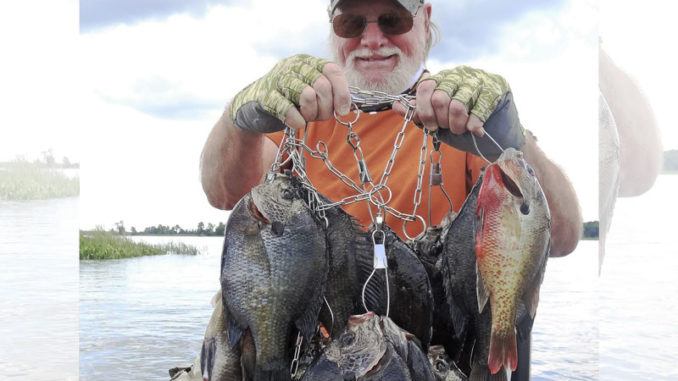
It’s big bream time in South Carolina
Bream fishing reaches a fever pitch across South Carolina as summer arrives, and most lakes and rivers are full of these aggressive, hard-fighting fish. The key to catching the biggest and most bream is targeting the right waters with the best techniques. Here’s where to find great bream fishing this month.
Cooper River
The Cooper River downstream from Lake Moultrie’s Pinopolis Dam is a big-bream factory that produces outlandish-sized bluregills and shellcrackers in vast numbers.
Wyn Mullins of North Charleston, S.C., has fished the river for bream for more than 50 years. He said it is influenced by tides. And the key to fishing success is understanding and utilizing rising and falling water to your advantage.
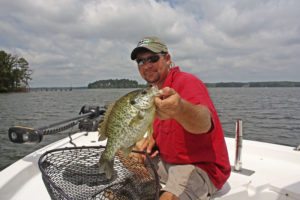
“Bream action is excellent on the Cooper River, with bedding activity around the full moon. But great fishing also exists when fish are not bedding,” said Mullins, who looks for bedding fish in at least a foot or more of water at all times. If the water totally recedes during the low end of the tide, it’s not a good bet for bed fishing. He keys on pockets with a sand and gravel substrate. And areas near a small ditch or creek are his favored targets for bed-fishing.
Look for intersections
When searching for scattered fish, Mullins keys on deeper water along the main channel and creek intersections.
“They’re going to be near or in deeper water and close to nearby aquatic growth that harbors summertime forage,” he said. “By June, the river is full of aquatic growth.”
Bream are usually found near the mouth of a pocket or creek junction when the tide is low or falling, he said. As the water rises, fish move further back into pockets because of sufficient water depth.
“The important aspect is to remember that tides impact where the fish are found because of changing water depths” he said.
Mullins said bream can be caught on any tide. But his favorite is either side of the high tide. Crickets are his bait of choice for bream. He chooses redworms for shellcrackers.
Upper Lake Marion
The upper end of Lake Marion is a mecca for bream fishing because of its size and the unique habitat. This area produces huge bream and giant shellcrackers in almost ridiculous numbers.
Kevin Davis, the owner of Blacks Camp, said the upper end of Marion is a prime bream and shellcracker target.
“The diversity of cover in the flooded cypress flats provide ideal habitat,” he said. “I look for the deeper runs or ditches cutting through these flats and fish the nearby shallow water.”
Davis said the best way to find bream in this close-quarters habitat is to stay on the move, fishing various objects at different depths. Targets include cypress and gum trees, weedbeds, stumps, logs and brush. Most fishermen use 10- or 12-foot poles or small spinning or spincast rigs they can cast sidearm under branches.
“It’s crucial to accurately place your bait near the target,” he said. “Both shellcracker and bluegill will bite live crickets or worms. But to target shellcrackers, use redworms.”
Davis doesn’t linger in any given spot unless he is catching fish. And this technique consistently produces scattered fish or finding that bed of giant bream or shellcrackers.
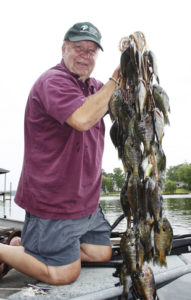
Lake Murray Shellcrackers/Bream
Bream and shellcrackers are on a strong bite at Lake Murray. So anglers have the opportunity for a double-dip of these two species.
Guide Brad Taylor said the key for finding either species is locating the right habitat. But each have specific preferences at this time of the year.
“Bream and shellcracker prefer sandy or pea-gravel bottoms when bedding,” he said. “Shellcrackers may still bed in June. But they are much more likely to be on the rocky humps and ledges found throughout the lake.”
Bream fishing is excellent whether the fish are bedding or not. Taylor (803-331-1354) said bream prefer shallow water in the back of coves around woody or weedy cover. He said about three days on either side of the full moon is prime time for bream bedding.
When targeting shellcrackers, he fishes humps and ledges that rise to 6 to 12 feet and drop quickly into deep water. Taylor anchors near the top of the hump or ledge and fan-casts rigs around the boat toward deeper water.
“I use 10-pound test line with a No. 2 Aberdeen gold hook baited with about half a night crawler,” he said. “A few inches above I clip a No. 7 split-shot, and above that I place a 2-inch slip float that is allowed to slide completely free. The float reduces snags in the rocks. When I reel the baits in to check them or move, the float will enable the line to rise straight up out of the rocks.
“I use eight rigs, and usually, by the time I get them set out, I’m getting bites if it’s going to be a productive place,” he said. “Once I get a depth pattern, it generally holds true for that day.”
Clarks Hill Lake
June is a prime time for bream and shellcrackers on Clarks Hill Lake. Guide Wendell Wilson said fishing for bream and shellcracker is excellent throughout May and June.
“The really cool thing is that it’s not difficult to be successful on either of these species. And the gear and tackle requirements are simple,” he said.
Wilson (706-283-3336) said bluegill and shellcracker will bed on full moons, but both species are caught around the shoreline throughout the month.
“The bluegill are found on sandy bottom banks, and usually, if you find woody cover along that bank in 2 to 5 feet of water you have a potential hotspot,” Wilson said. “Live bait is a killer, but a lightweight fly rod with a popping bug is a load of fun. And catching bream on topwater is exciting and productive.
“To catch shellcracker, I fish a bit deeper, and worms becomes key to consistent success,” he said. “Fish those same sandy banks, but back off into 6 to 9 feet of water. Keep the boat in deeper water and cast toward the shoreline. One rig that works great is a to put a split-shot about a foot above a No. 4 wire hook with a gob of redworms on it. Cast it to the bottom with no float and slowly work it in. When you catch one shellcracker, odds are good more are in that immediate area.
“Another tactic that works great is to use a 1/16-ounce crappie-type jig, but you need to thread a piece of night crawler on the hook and cast it out and work it back.”
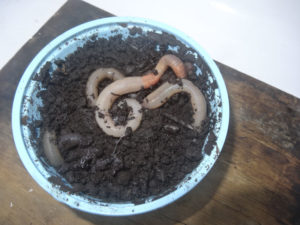
Sleeper Bream Lake: Wateree
Lake Wateree is loaded with bream, and they’re caught in prolific numbers, but with ample culling, quality fish in limit numbers are caught.
Local angler Frankie Jacobs hunts big bream at Lake Wateree; he said employing a variety of techniques is his key.
“Lake Wateree has some big bream, but you’ve got to cull to keep a limit of those fish,” Jacobs said. “My wife and I often fish together, and she’ll use live bait, such as crickets or worms, while I prefer a small jig and plastic grub.”
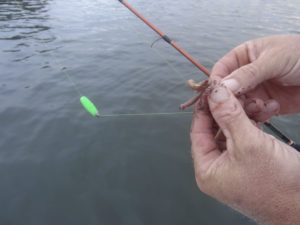
Jacobs uses a 1/32-ounce jig with a chartreuse, flat-tail grub that’s deadly on bedding bream. On 4-pound test line, the jig falls at just the right speed to tempt bigger bream.
But he said live bait is an almost a can’t-miss method
“Fish gravel or sandy shorelines in coves and pockets that drop into a few feet of water for bedding fish,” Jacobs said. “Cast ahead of the boat around stumps, logs, weeds or docks.”
When targeting bream that are not bedding, Jacobs recommends fishing faster and fishing woody and rocky shorelines along deeper water. Using worms is a good idea because a virtually untapped resource of healthy shellcrackers swim around in Lake Wateree.
“The lake is chock full of bream, but bring plenty of crickets, cull early and often, and you can haul a heavy limit home,” he said.

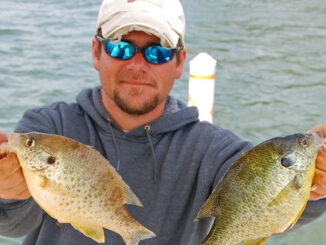

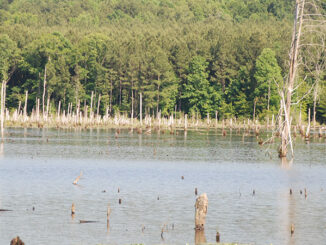

Be the first to comment